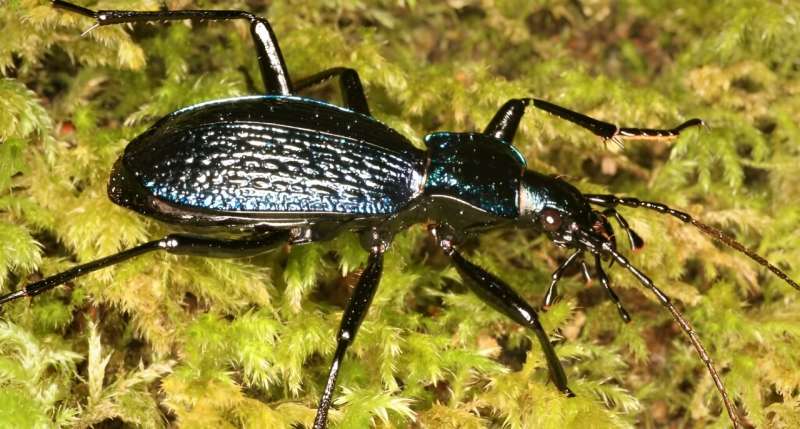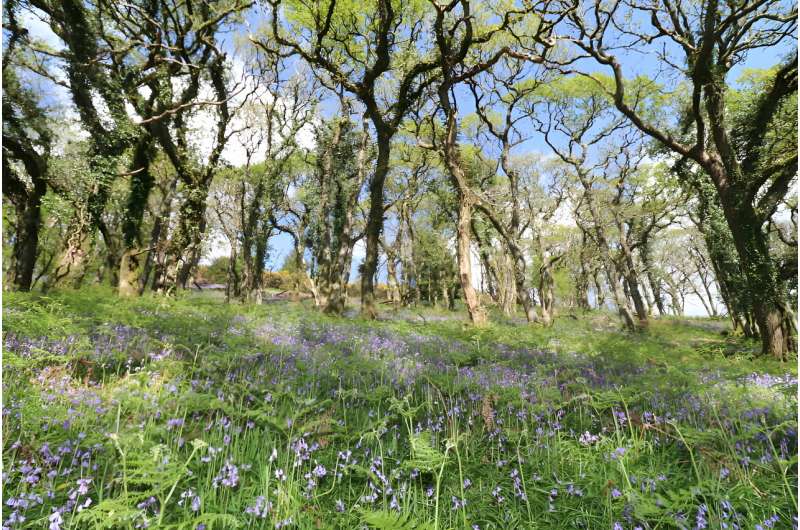This article has been reviewed according to Science X's editorial process and policies. Editors have highlighted the following attributes while ensuring the content's credibility:
fact-checked
trusted source
proofread
UK's rarest rainforest beetles go on multi-day 'adventures'

A new study delving into the lives of one of the UK's rarest beetles shows them to be athletes and adventurers—sometimes traveling the scaled-up equivalent of several kilometers a night in search of food and mates.
Confined mostly to temperate rainforests fragments in southwest England, the blue ground beetle is an elusive animal about which little is known. However, working alongside the Woodland Trust and others, scientists investigated how and where they thrive.
This could provide an invaluable insight on how the Trust and others could protect and restore these rare habitats, which are typically small and patchily distributed in the UK.
Dr. Nick Royle of the University of Exeter, who led the study with Ph.D. researcher Brogan Pett, said, "Blue ground beetles are one of the largest and rarest species of ground beetle in the UK with a very restricted distribution, mostly on Dartmoor. However, we know relatively little about its biology, particularly how it uses the habitat it is found in, and what characteristics are essential for it to thrive. Such knowledge is essential to be able to develop successful conservation practices to boost populations, which are currently highly fragmented."

Scientists from the University of Exeter are working on a Natural Environment Research Council Ph.D. research project to track how these beetles move about their forested habitats in Dartmoor National Park, using a unique kind of tracker—a "beetle backpack."
The team placed radio trackers on 36 of the insects to record their daily movements. They found that some beetles were faster and more adventurous than others.
Researcher Brogan Pett said, "Individuals varied considerably in how active they were and how much they moved around the forest. One male whose tag number was R9 turned out to be a real athlete, traveling over 25m within the forest each night, which is the scaled-up equivalent of several kilometers.
"The beetles are only active for a few months a year during warm, humid evenings in late spring and early summer to feast on slugs and other prey and to search for mates, so they have a limited time to get things done. Our radio-tracking revealed that they also prefer to stay away from the outside border of their woodland habitat, with individuals resting up during the day in mossy logs of decaying deadwood or in cracks in trees in shady parts of the forest."
One characteristic shared by all the beetles was a preference for old growth temperate rainforest, with plenty of decaying deadwood and an abundance of available prey.
Sam Manning, Woodland Trust site manager, said, "The data from the project will help inform vital decisions about how we manage our precious rainforests. Blue ground beetles are an important indicator of a healthy rainforest here in the southwest, so we can see exactly what is it they need to thrive and repopulate.
"The research has already shown that blue ground beetles prefer occupying areas with old growth temperate rainforest characteristics, with high availability of decayed dead wood on the ground and forest canopy cover. It will help us to create a resilient landscape and establish what scale of woodland habitat restoration and new connections are needed to help build that resilience."
Otherwise known as Atlantic woodland, temperate rainforest is found in areas subject to the influence of the sea. These places have high rainfall and humidity and a low annual variation in temperature. In the UK, they lie to the west coast of the country but are very rare.
This unique habitat of ancient oak, birch, ash, pine and hazel woodland is made even more diverse by open glades, boulders, crags, ravines and river gorges.
The Woodland Trust is working with various partners in the south-west, Scotland and Wales to form multi-partner alliances to help protect these environments for the future. Full analysis of the findings are due out in the autumn.
Provided by University of Exeter


















